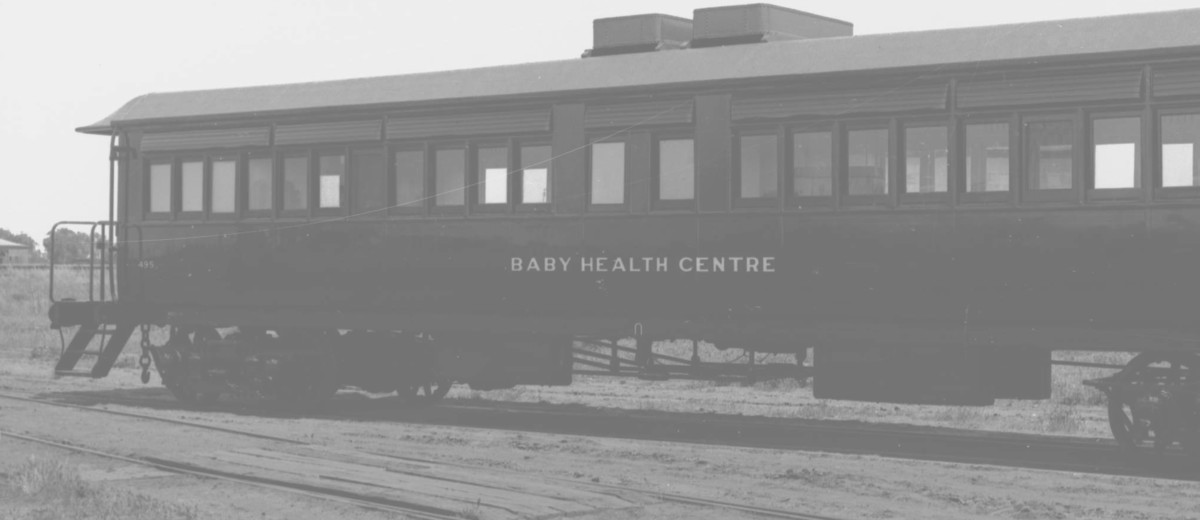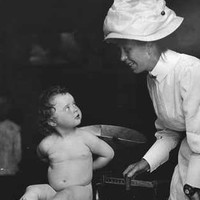Organisation
ContributeFor several generations the Mothers’ and Babies’ Health Association (MBHA) and its successors have been a highly respected source of support and reassurance to South Australian families with young children. The MBHA developed from the Adelaide School for Mothers, which was established in 1909 by Dr Helen Mayo and Miss Harriet Stirling. Like similar bodies formed elsewhere then, its aim was to reduce infant mortality by providing expert advice to mothers. Such a politically non-contentious strategy, which deflected attention away from evidence that health and illness were largely socially and economically determined, was attractive to governments, health professionals and mothers, and allowed the MBHA to flourish, readily attracting voluntary support and government funding. As its services proliferated, infant mortality rates fell and the MBHA regularly claimed, though it could never demonstrate, a simple, causal connection between the two developments.
While some of its program, including the mothercraft hospital and training school Torrens House, was run from its Adelaide headquarters on South Terrace, for most clients the MBHA was the local baby health centre where MBHA sisters monitored babies’ growth and dispensed advice on feeding and management routines. In the organisation’s heyday, MBHA staff were in contact with the overwhelming majority of young families in rural areas as well as suburban Adelaide and from the 1930s to the 1950s three Baby Health Trains took clinics to small, isolated communities.
By the 1960s the MBHA philosophy and practice were being challenged by the needs of a more complex community, and parents were in time recognised as active participants in its programs rather than passive recipients of standard advice. Name changes to Child, Adolescent and Family Health Services (1980), Child and Youth Health (1995) and Child and Family Health Service (2011) within the Women’s and Children’s Health Network reflected two important developments: the incorporation of a formerly private venture into the South Australian Government’s health services system, and the growth of broader and more sophisticated understandings of the determinants of infant well-being.
Media
Add mediaImages

Courtesy State Library of South Australia, SLSA: B 56349, no known copyright.

History SA. South Australian Government Photographic Collection GN 07196

Courtesy State Library of South Australia, SLSA: B 12846, no known copyright.

Courtesy of State Library of South Australia, SLSA: BRG 347/2352, no known copyright.


Comments
CommentAdd new comment
I'm not 100% sure David, but perhaps try the annual reports of the Mothers and Babies Health Association - https://catalogue.nla.gov.au/Record/128273
Hullo Catherine
I read an article about the MBHA in South Australia. I am trying to find all of the original clinics. I understand there were 100 of them an many have become the responsibility of local government. Can you direct me to a source of information about these clinics?
Sincerely
David Lymn
Hi Judith, we'd love to see the photo! You can e-mail us via adelaidia at history.sa.gov.a (removing spaces and replacing at with @) or through the Site Feedback link below. You can also click on the 'contribute' button above to add more of your story and upload your picture directly on the site.
Recently our Mum Barbara Samuels died and in her scrapbooks my twin sister and I found a card for the Baby HealthTrain. So interesting. We were the first twins born at the Riverton Hospital 11.11.58. would you like a photo of it I took? Judith Knight nee Samuels.
Hi Ross,
One place you could start is the annual reports of the Mothers' and Babies Health Association. They can be found at the State Library of South Australia - http://www.slsa.sa.gov.au/archivaldocs/srg/SRG199_MothersandBabiesHealth...
I had an Auntie, Sister Norma Macdonald, who worked for many years as a "Train Nurse" and in addition to the Peterborough run, she also did the West coast out of Port Lincoln. There could have been other areas, including the city clinics.. I was looking for any recorded details of her contribution. Peterborough was her old home town, and I was born there myself. Generations of Macdonalds were born and lived in parts of the Mid-North, particularly Orroroo , Clare, and up to Peterborough, Melrose, Pt Augusta etc .....I shall watch these on-going conversations with interest. Ross.
thank you
The National Railway Museum at Port Adelaide is embarking on an oral history project, and the Baby Health Train is high on the list of topics. It is likely that most of the Nursing Sisters who did the work have sadly passed on, but there would still be many country mothers still alive, who would have used the service in the 40s and 50s. Older siblings of the babies may have stories to tell. Moana Colmer is the curator at the National Railway Museum, who is heading this project. Of particular interest is Sister Lapworth, who was synonymous with the Baby Health Train from 1932 to 1935. I shall keep you informed as the research and book project evolve.
Hi John, I know of research on the Nursing Mothers related to the Mothers' and Babies' Health Association, but not to date on the Baby Health Train, it would be a great topic to look into further. Your book sounds fascinating, I'll keep an eye out for that one.
I am writing a history of the Riverton to Spalding railway which will be published as book "The Riesling Railway" to be published in July 2018 which is the centenary of the opening of the line to Clare. There will be a chapter on the MBHA "Baby Health Train". I am researching this in conjunction with the National Railway Museum. I plan to expand the chapter to cover the history of the train on all lines. A lot of research has already been done. When the train commenced in 1932 the first run was Riverton & Clare. I note that you make mention of another researcher considering this topic. Has there been any serious research already done on this topic?
What a great memory Judith, we'd love to get a more detailed article up eventually with further information on the baby train. One for the (long) list.
Hi Judith, unfortunately we don't hold those records. I'd say the best place to start looking is at State Records: http://www.archives.sa.gov.au/ if they don't have what you're after they'll probably have a pretty good idea where else to try.
We had a query today at the History Rooms about a nurse who worked on the Baby Train from 1946 to 1959. Her name was Dorothy White. Do you have records of all the staff who worked on these trains and their stories?
The baby train was still operating in the Peterborough SA Railway Division in 1968 because I attended it with my first child and it still went up the track from here to Cockburn. By 1970 the train was discontinued.
Thanks for joining all those dots Brian!
Judith Raftery, author of this entry, is probably not aware of the fact that she is related to Dr Helen Mayo and Harriet Stirling. She is also related to Catherine Manning, whose comment appears below.
Hi Rosslyn,
I would recommend looking at State Records first, http://www.archives.sa.gov.au/, if they don't hold the records on Torrens House I'm sure they'll have a good idea who does.
I Rosslyn Kae Tuoy was born 7/4/1954 Port Pirie South Australia.
I spent some time in Torrens House when I was only 8 weeks old.
Would the hospital still have records of this time.My mother has passed away now all I know I was in Torrens house after I was born.
Thankyou I would appreciate any help you can give me.
Thanks for your thoughts Jasmine,
(and apologies for the slow reply, your comment was buried by our over-zealous spam filter). The Mothers and Babies Health Association certainly has a fascinating history. We can add links and further information on the SA History Hub version of this article, so let us know if you have any more to share.
Was interested in the Mothers and Babies Network and found there have been several title, business, legal, political and voluntary negotiations since the 1980's that have made it a very Complex community based service for mother and Baby. Do believe however that Mothers and Babies had it right though, in being a "Local Baby health clinic" because fostering competence by alleviating uncertainties, with reassurance, genuine concern, common sense and beneficence ought to commence before a problem becomes imminent. Basing these services with a professional team of experts is costly, and being hospital and health centre based is very "Illth-orientated". However the electronic link to "Womens and Childrens Health Network ", http://www.cyh.com/SubDefaultaspx?p=98 can be very useful for the computer literate mother.